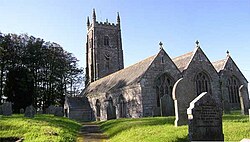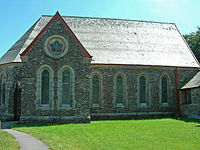South Petherwin
| South Petherwin Cornish: Paderwynn Dheghow | |
| Cornwall | |
|---|---|
 South Petherwin church | |
| Location | |
| Grid reference: | SX310818 |
| Location: | 50°36’43"N, 4°23’24"W |
| Data | |
| Population: | 931 (2011) |
| Post town: | Launceston |
| Postcode: | PL15 |
| Dialling code: | 01566 |
| Local Government | |
| Council: | Cornwall |
| Parliamentary constituency: |
North Cornwall |
South Petherwin is a village in eastern Cornwall, three miles south-southwest of the town of Launceston, on the road from Launceston to Liskeard. It is within East Wivelshire.
The wider Parish of South Petherwin bounded to the north by the Launceston parishes, to the east by Lawhitton and Lezant parishes and to the west by Trewen parish. It does not adjoin North Petherwin, which is found north of Launceston, across the River Ottery in Devon as Launceston stands between, but in the Middle Ages the parishes did adjoin, before Launceston was created as a town between them. The parish population recorded at the 2011 census was 931.
Parish church
The parish church, St Paternus, stands in the heart of the village. The church's tower has pinnacles and battlements and it houses a ring of five bells.[1]
The Saint, Patern (or Padarn, Paternus) has had several candidates, which have become mixed and confused over the ages. It is said that the actual St Patern to which the Parishes of North and South Petherwin are dedicated, was actually the father of St Constantine of Cornwall, a Cornish King who gave up his throne to become a monk. St Patern and St Constantine have thus frequently been linked or close by one another.
History
King Edmund the Elder abolished the Cornish diocese of St German's and created a Diocese of Crediton to cover Devon and Cornwall. The church lands in this area came into the hands of the bishop and the estates of North Petherwin and South Petherwin, divided by the River Kensey grew wealthy. From South Petherwin was created the monastery of St Stephen in Dunheafod, which from this became Lan Steffan: Launceston.
In the Norman period St Stephen's was reduced as a monastery and the priory was moved across the Kensey to Newport. South Petherwin remained the Mother Church for the growing town of Launceston, and it is the church's importance in providing a valuable source of income to the church as a whole, that accounts for the size of the church building when it was rebuilt in the fifteenth century. Its significance is also shown by the existence of five roads which all lead to the church. (Three of these still exist as normal tarmac roads; one is a footpath leading across fields from Tregadillett, with a fifth road from Trecrogo, which is now blocked off.) The estate was much larger than the present parish and also included Trewen.
Parish Church

The church consists of a chancel, nave, north and south aisles, and vestry. The chancel was restored in the 19th century. The arcades each consist of six four-centred arches, supported on monolith granite pillars. There are north and south porches. The tower has three stages, and is buttressed on the square; it is wholly built of local stone apart from the battlements and pinnacles which are of granite. The belfry contains six bells and a clock.
There was a 'holy well' in a field at Oldwit Farm, where water was collected and brought to the church each time a baptism took place.
A prominent monument in the church s to Ambrose Manaton, a local landowner and member of Parliament who died in 1651[2] and was buried at South Petherwin.[3]
Outside links
| ("Wikimedia Commons" has material about South Petherwin) |
